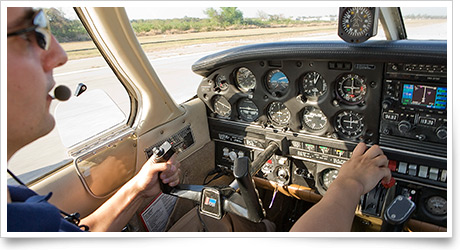| The following stories from the Oct. 26, 2012, edition of AOPA ePilot were provided to AOPA members who expressed an interest in the particular subject areas. Any AOPA member can receive information tailored to their areas of interest by updating their preferences online |
training tipsAll clear on final?
Suddenly your radio comes alive with a harried voice announcing a go-around. Because numerous airports share your local common traffic advisory frequency, it takes you a moment to realize that you may have caused the other pilot to balk a landing.
Not a good feeling; you try your best to maintain situational awareness, especially at a nontowered airport where you lack the reassuring backup of air traffic control overseeing air and surface movements.
This is also a major distraction, so maintain control of your aircraft! And try to spot the other aircraft.
Just as a conscientious pilot performs clearing turns airborne during the practice of maneuvers, ascertaining that there is no conflicting traffic is prerequisite to takeoff. It’s not enough to hear no chatter on the CTAF, or to assume that an inbound aircraft reporting a few miles out is the only local traffic.
Sometimes, you have to take extra pains to confirm that the pattern is clear. Not every airport has a spacious runup area just short of the runway threshold. Or, the space available for positioning your aircraft may not provide an ideal view of the traffic pattern.
Despite such constraints, strive to meet the standard that would apply on a practical test, namely that an applicant “ avoids runway incursions and ensures no conflict with traffic prior to taxiing into takeoff position.”
If you find that you must wait for a previously unseen (or unreported) aircraft, hold short of the runway. Then scan the pattern one more time before taxiing out (after the arriving aircraft has completely cleared).
Returning for landing after your flight, keep track of taxiing aircraft, and stay alert to the possibility that you may be the one who must react to a runway interloper. Such occurrences happen often enough that many pilots perform their first real-world go-around in such circumstances.
If you ever wondered why one element of a proper go-around is to “maneuver to the side of the runway,” this scenario provides the explanation: Doing so helps you “clear and avoid conflicting traffic,” as the test standard requires. training productsFLYpad notebookThe FLYpad notebook from PilotMall.com is a spiral notebook that includes a set of sticky notes of different sizes, so you can jot clearances or weather information and use the notes for reminders wherever they're needed. The pad is sized at 3.5-by-5.5 inches and includes 80 lined pages as well as two 24-piece sticky note pads attached to the first page. The back cover holds an elastic loop with a short pen. Priced at $4.99, the FLYpad can be ordered online or by calling 800/249-5730.
Note: Products listed have not been evaluated by ePilot editors unless otherwise noted. AOPA assumes no responsibility for products or services listed or for claims or actions by manufacturers or vendors. final examQuestion: What is the most efficient method for increasing horsepower in a reciprocating engine?
Answer: The use of a turbocharger is the most effective way to do that. A turbocharger is powered by the aircraft’s engine exhaust gases and acts to increase the pressure of incoming air into the engine’s induction system. This allows the engine to obtain sea level or greater horsepower at higher altitudes. For more on the use of turbochargers, read the Flight Training article, “Turbochargers: Better engine performance at altitude.”
Got a question for our technical services staff? Email [email protected] or call the Pilot Information Center, 800/872-2672. Don’t forget the online archive of “Final Exam” questions and answers, searchable by keyword or topic. |
 Pre-takeoff checks are complete. The engine ran up perfectly, and you are ready for takeoff. Positioning the aircraft on the runway center line, you add power, and a touch of right rudder, and begin the takeoff run.
Pre-takeoff checks are complete. The engine ran up perfectly, and you are ready for takeoff. Positioning the aircraft on the runway center line, you add power, and a touch of right rudder, and begin the takeoff run.

